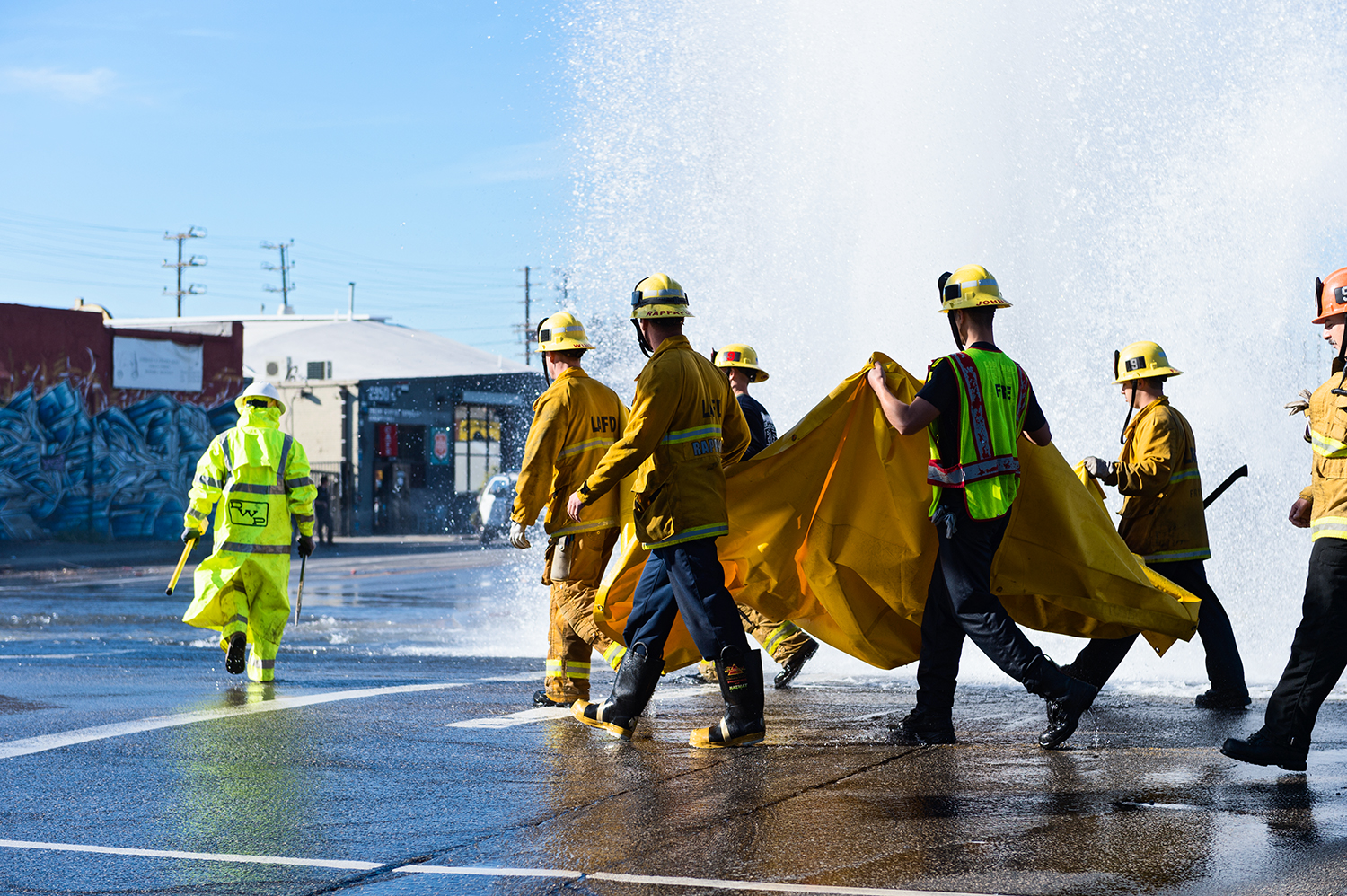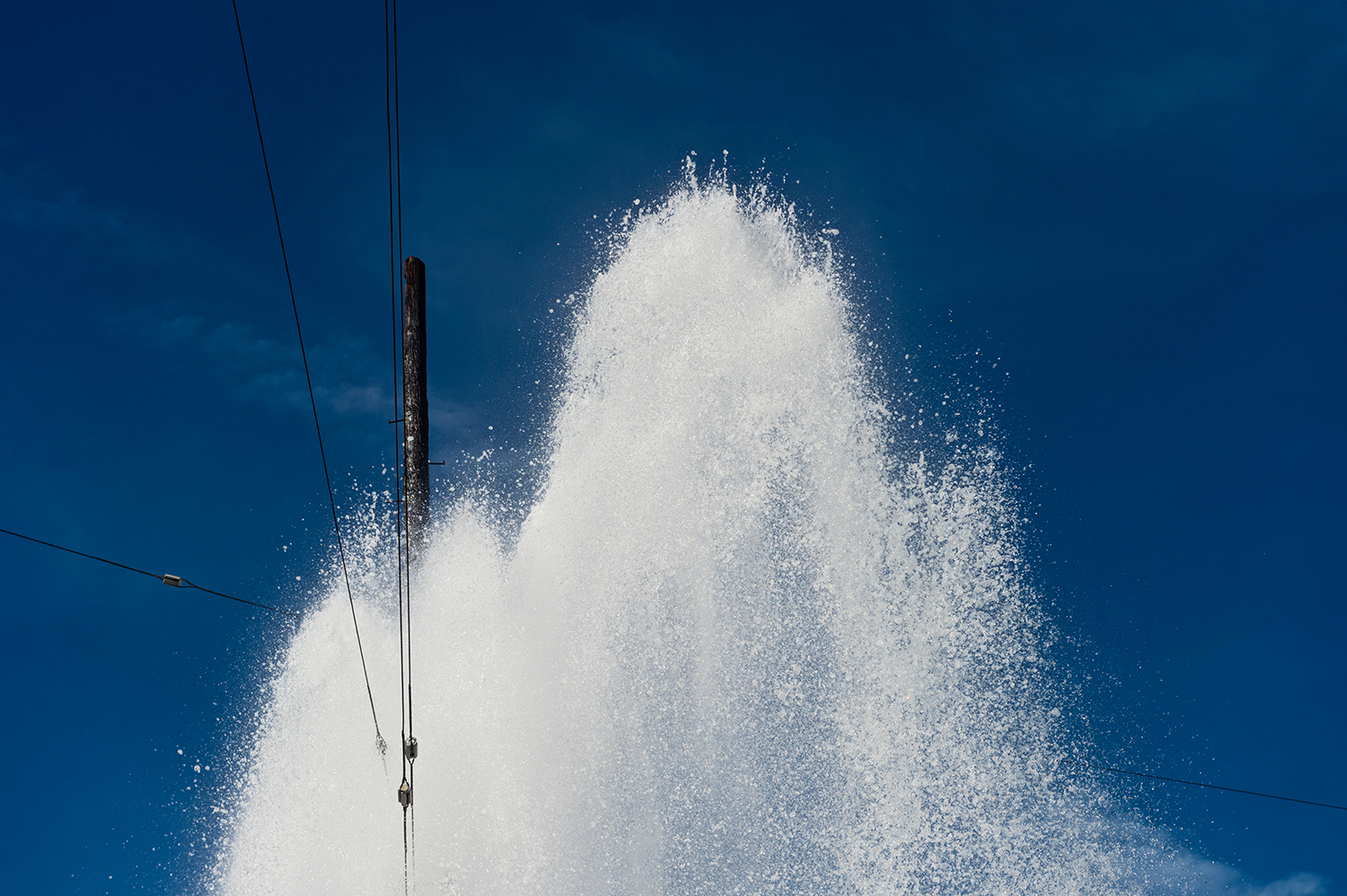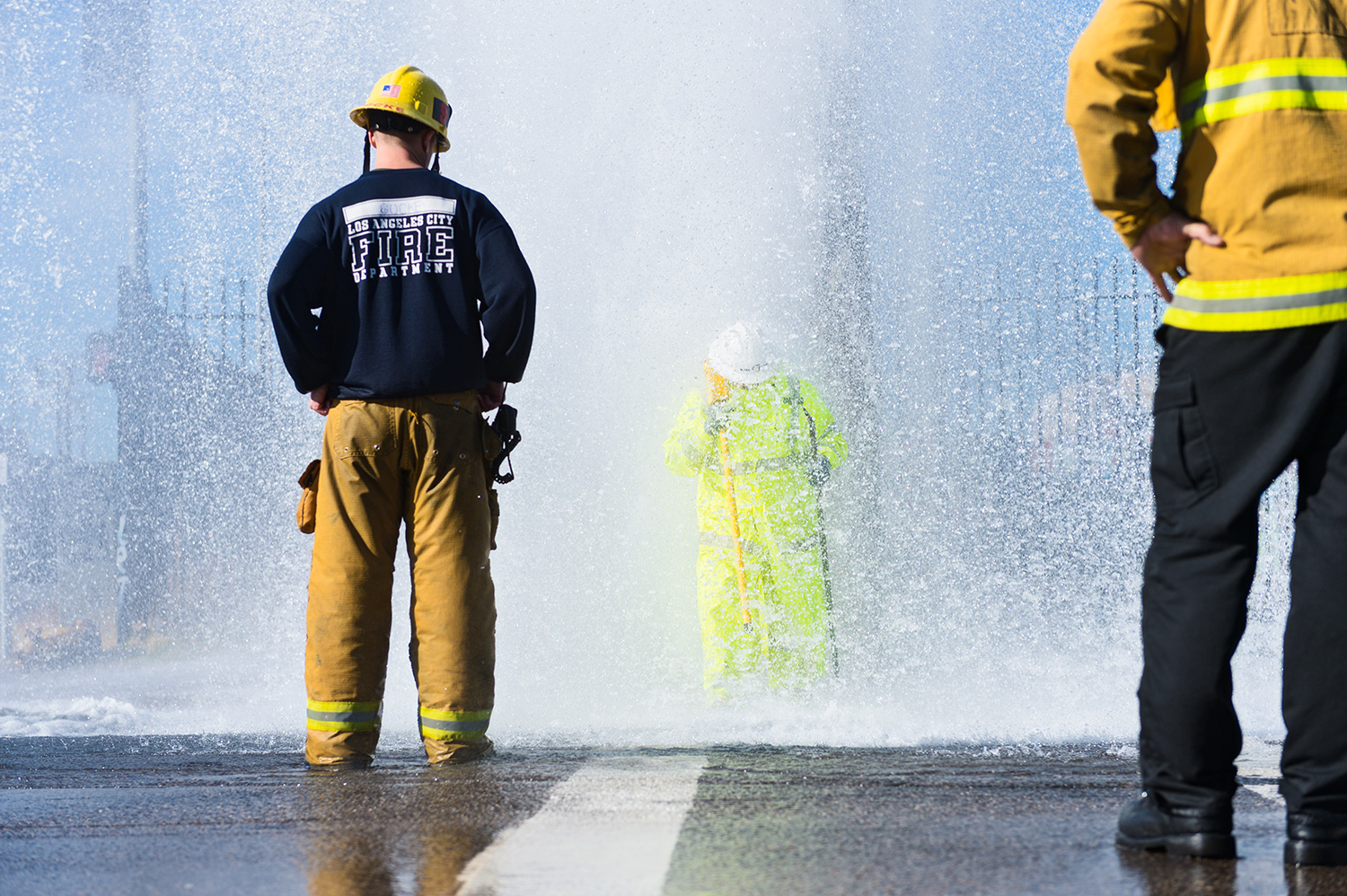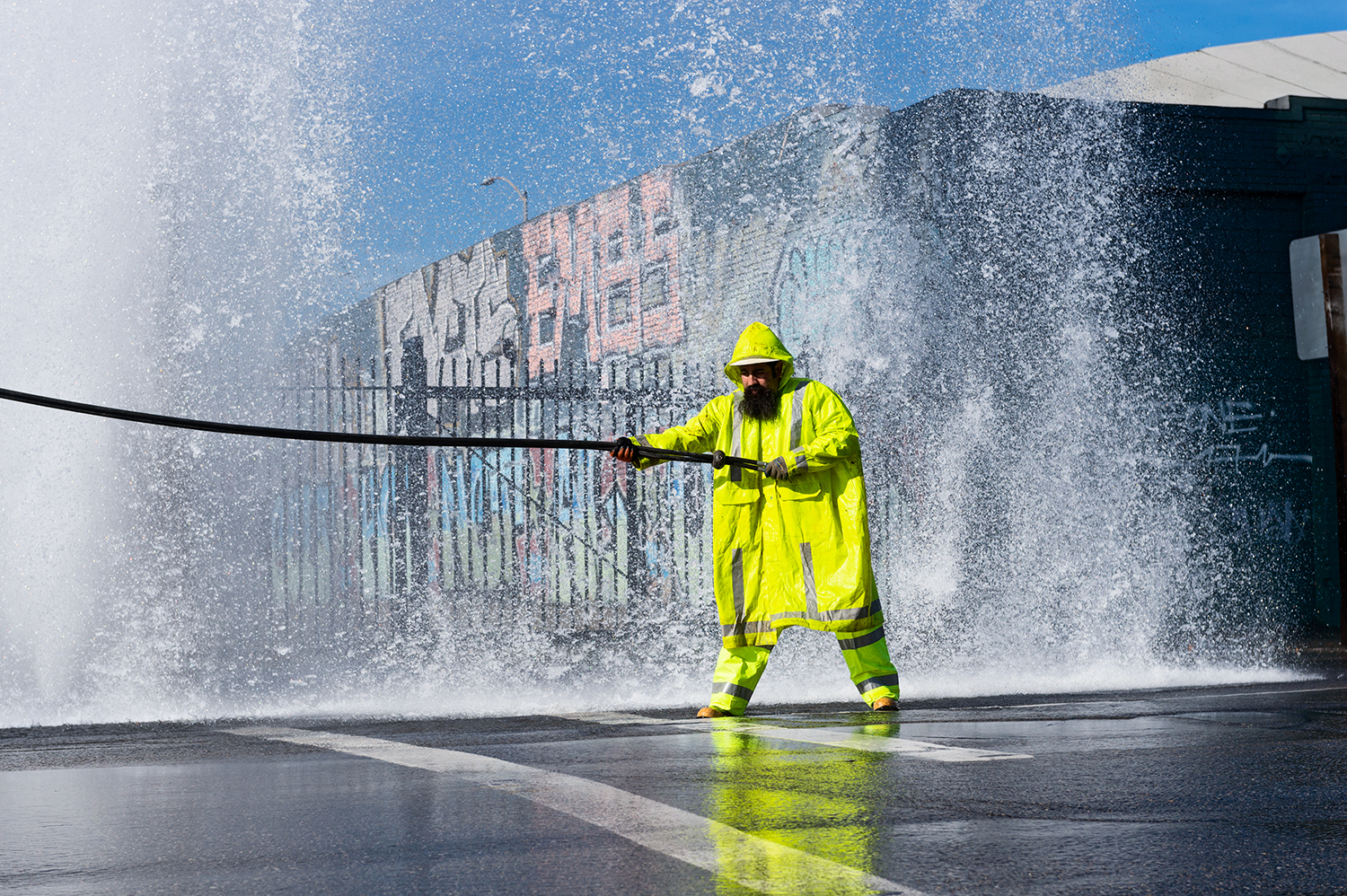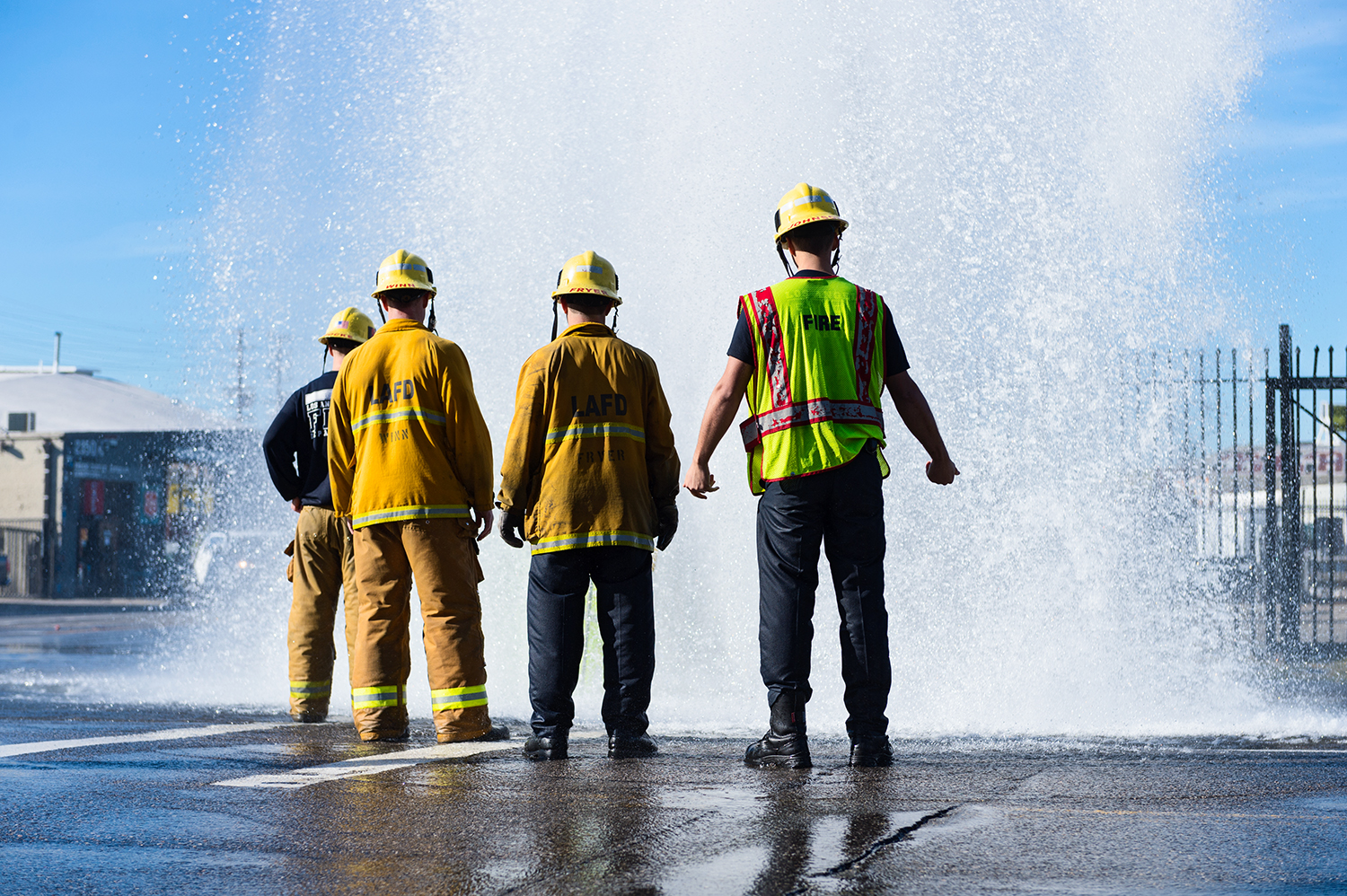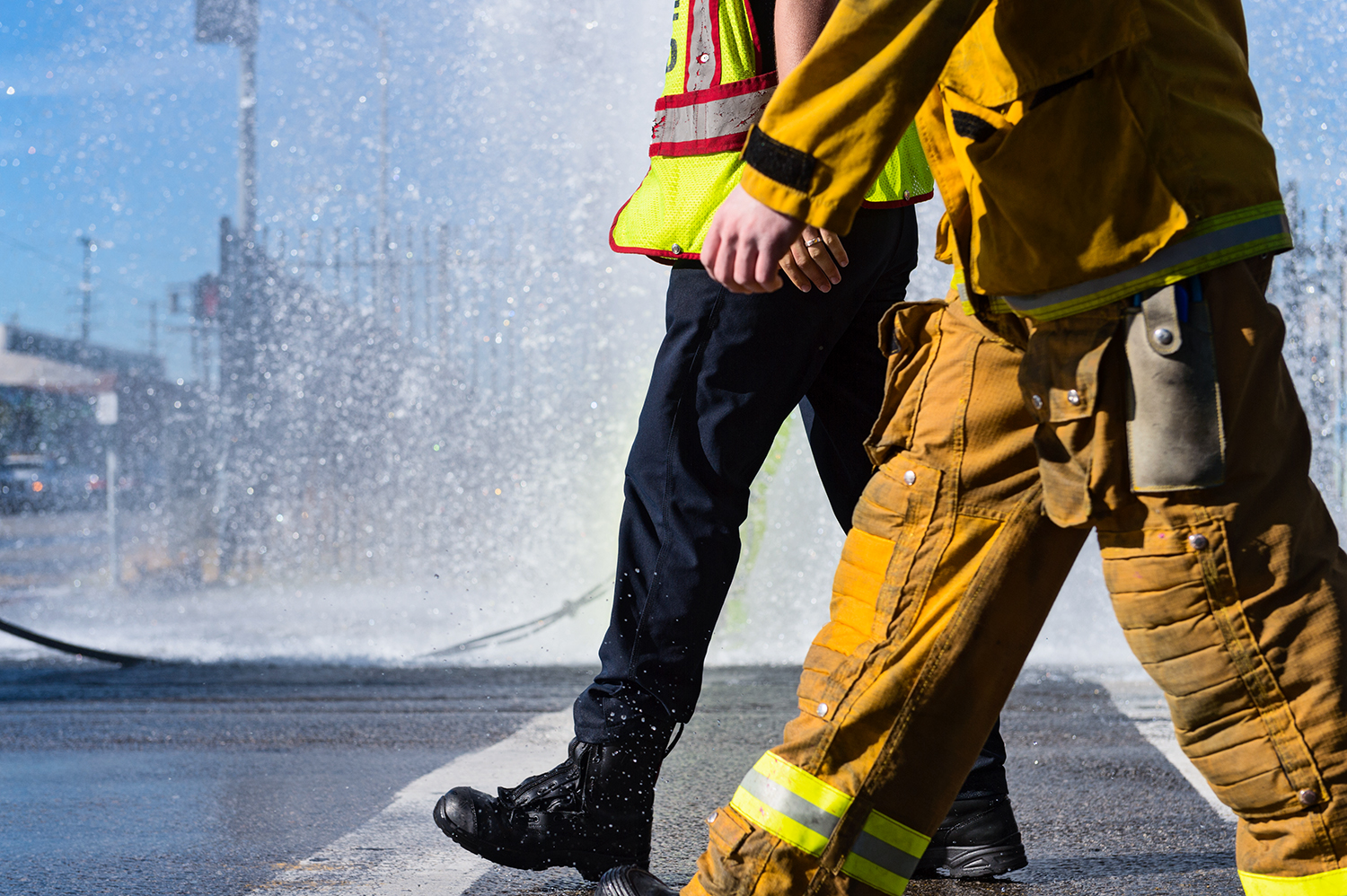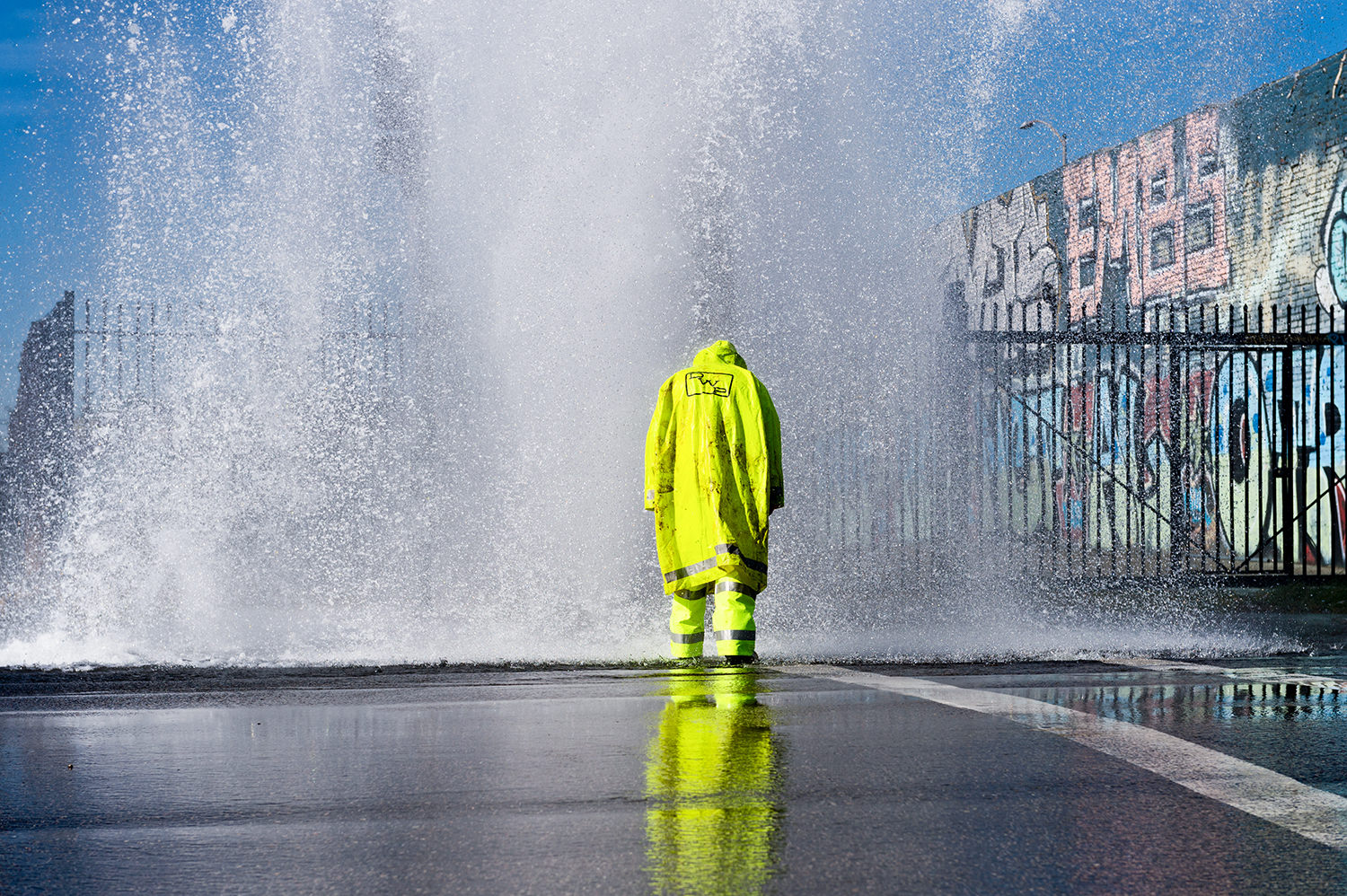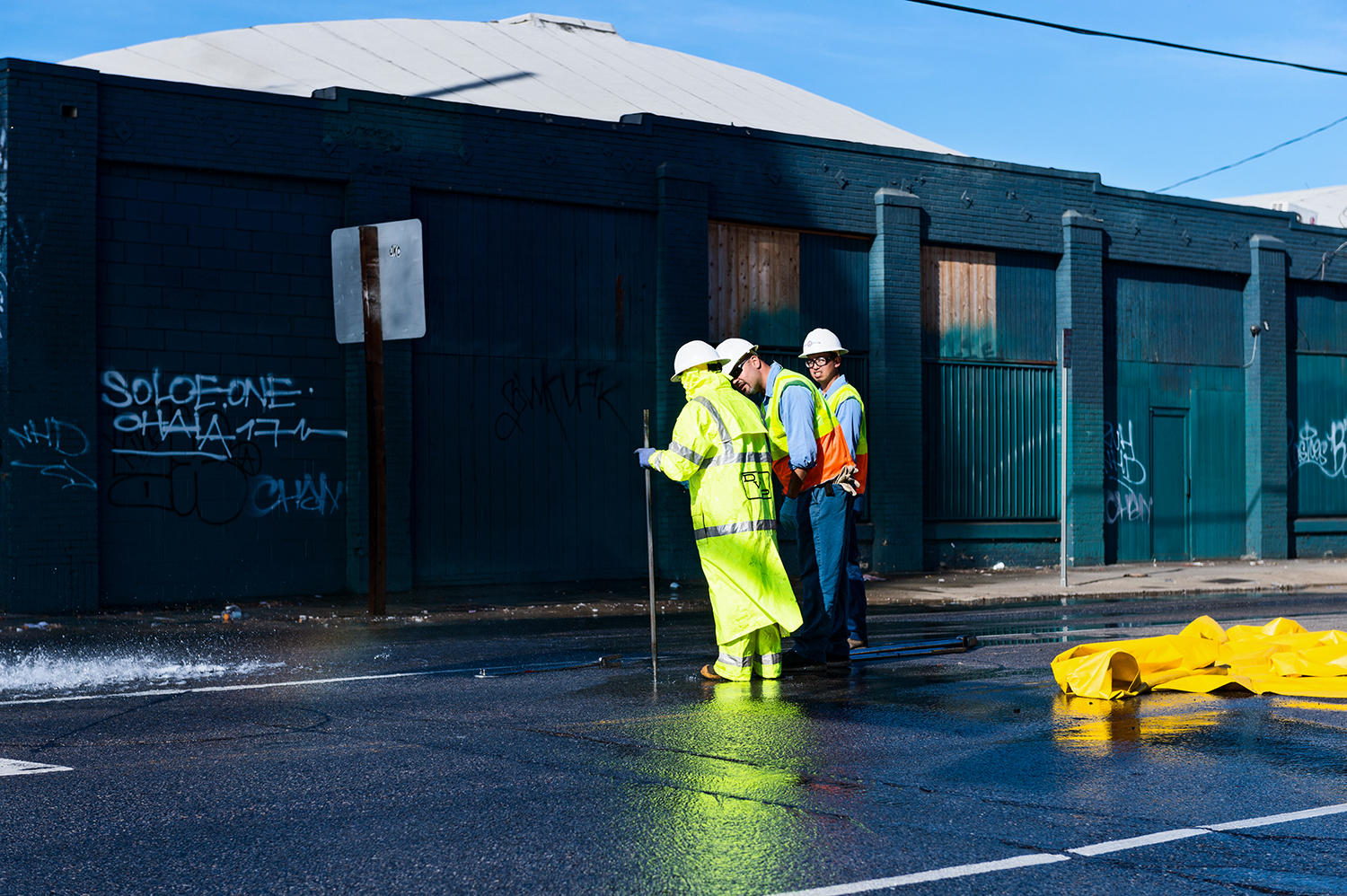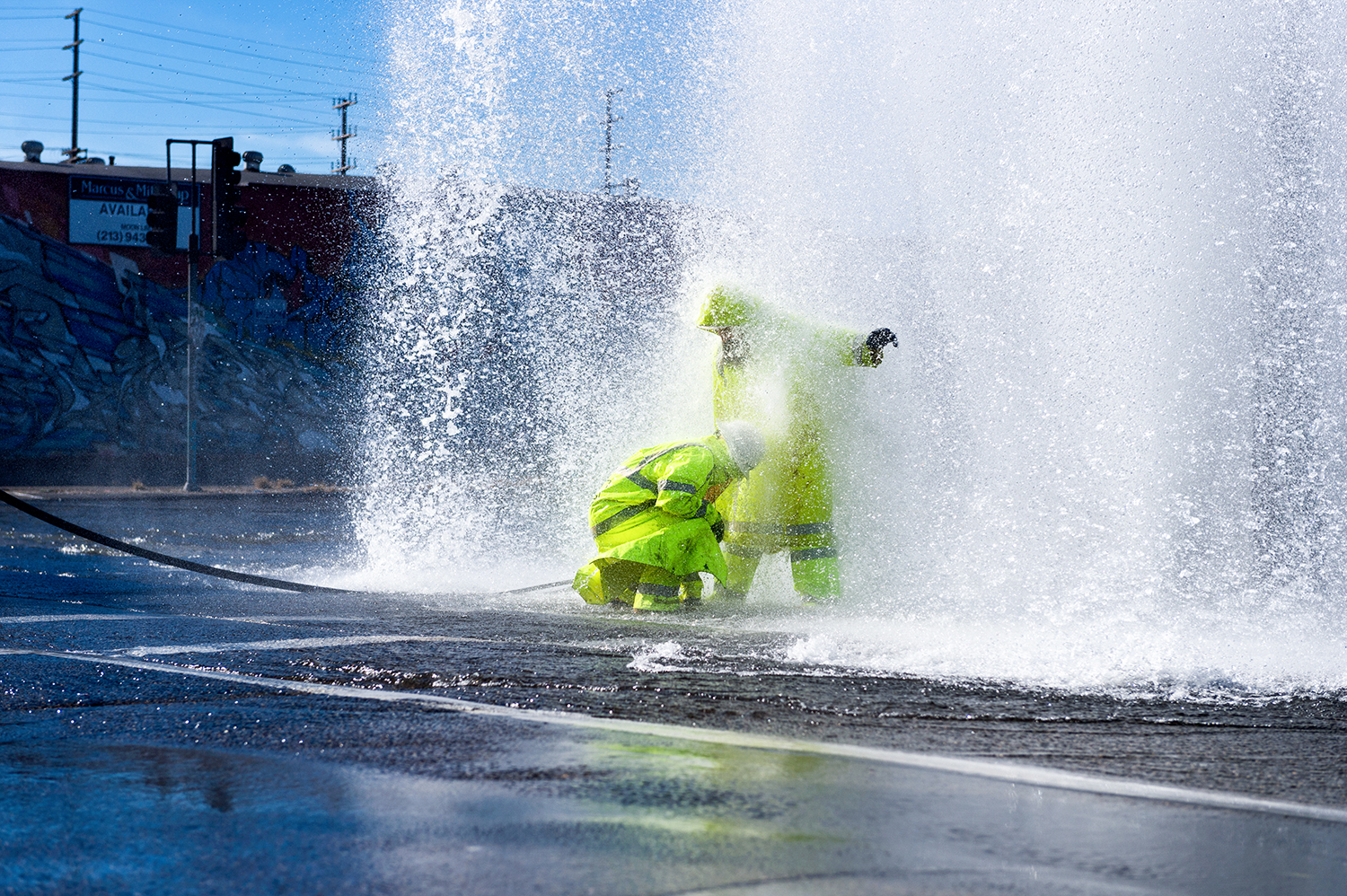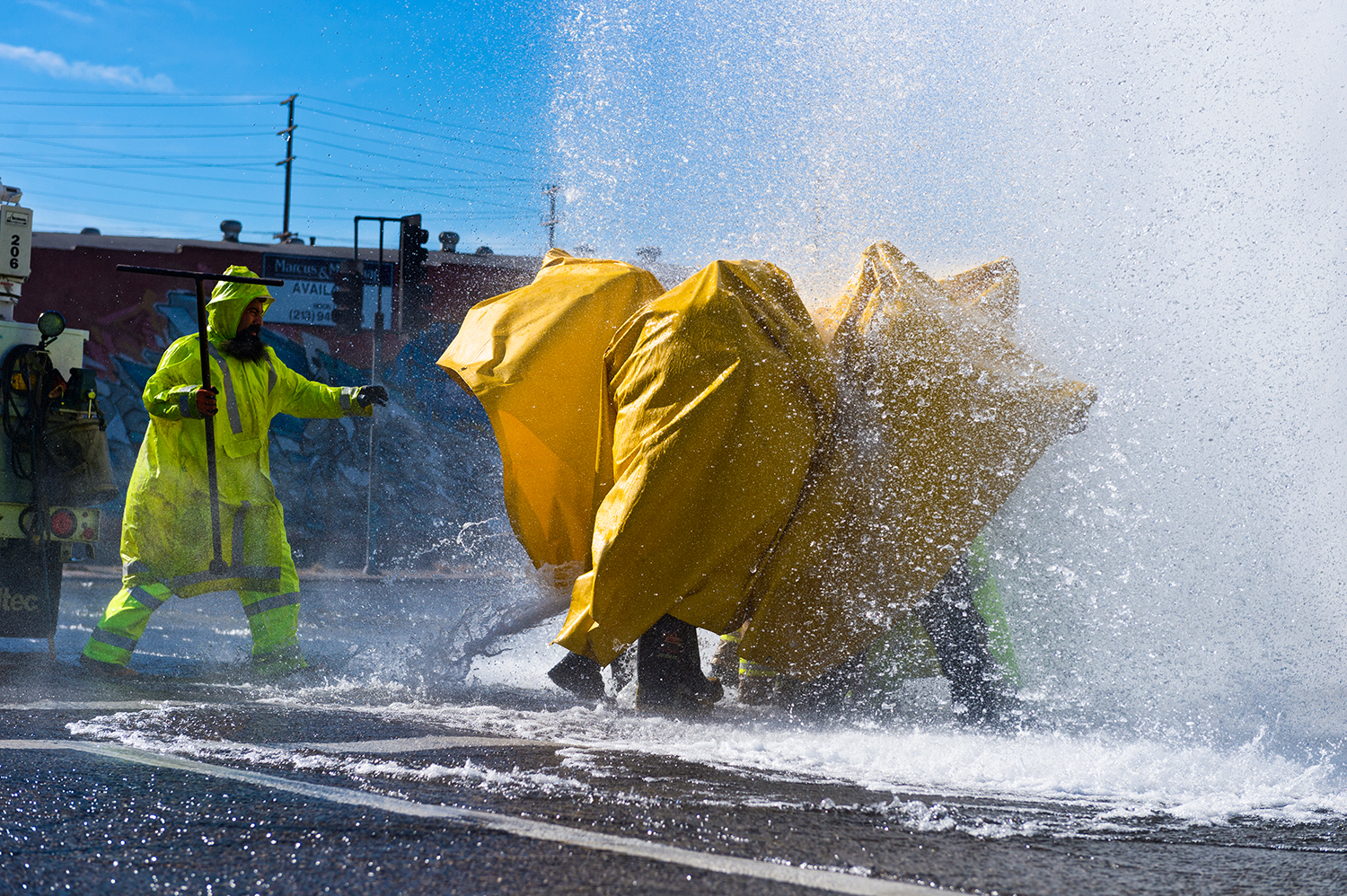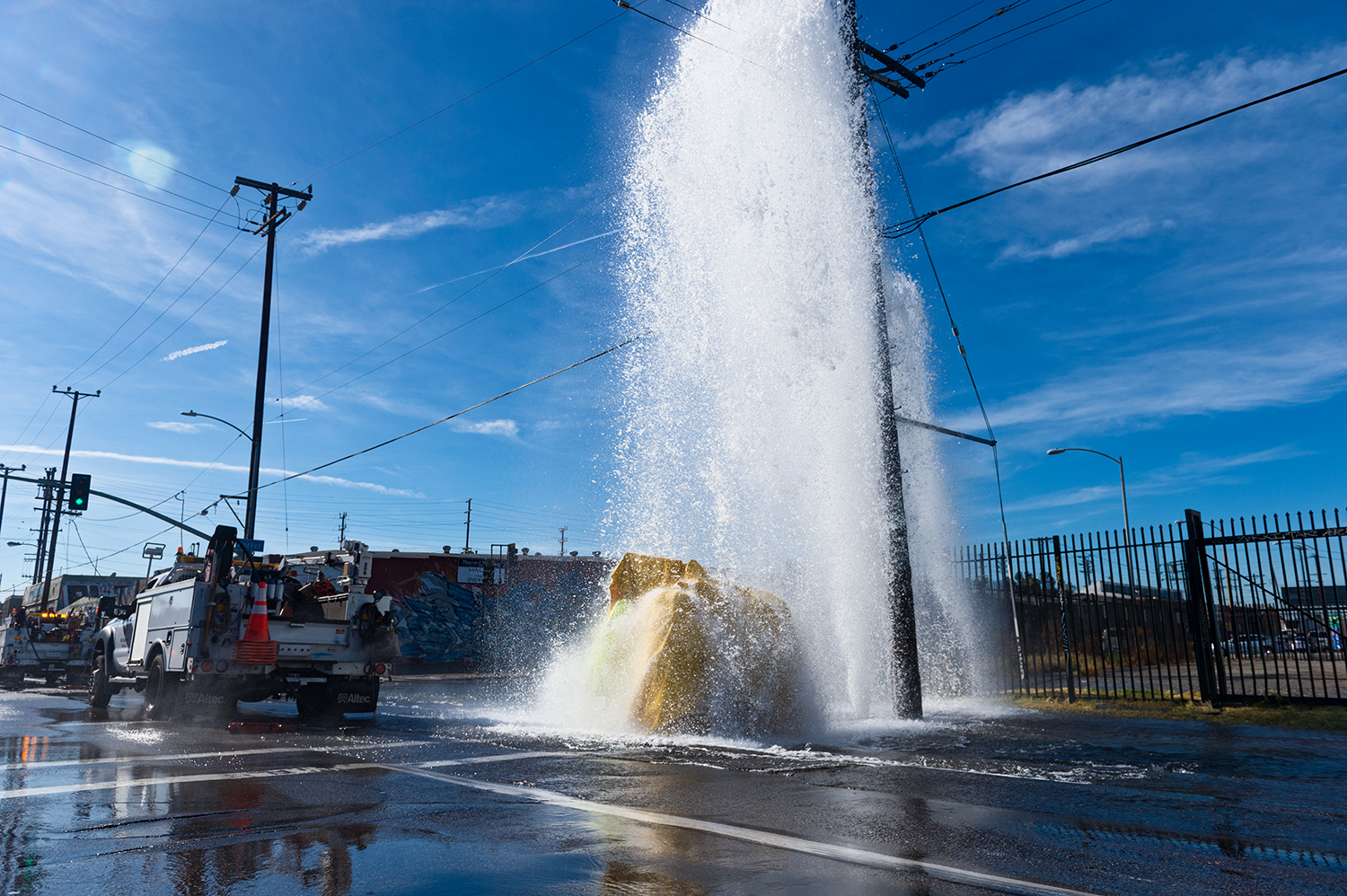Angeleno Falls
“Twelve hundred gallons per minute,” says LAFD Captain Garcia, gesturing at a forty-five foot tall geyser of Adam’s Ale spilling out onto Santa Fe Avenue. “That’s not good, we’re in the middle of a drought.” Looking around, Santa Fe is completely shutdown.
At the portal, where water rages from, used to stand a yellow fire hydrant. “Definitely hit by a truck. Probably didn’t even know he hit it,” says Captain Garcia. We’re told that the streets of Downtown Los Angeles aren’t designed to handle 52-foot tractor-trailers. “They were designed to handle the old 44-footers no problem.”
Underneath the pommeling waterfall are 5 firefighters. A yellow tarp is drawn over the men, sheltering them as they attempt to close the appropriate valve. “We know that the valve is nine feet off the curb, but with the water depth, and the force of impact, it’s very difficult to see anything,” the Captain commands. The firemen are wearing blue uniforms, their helmets and a few are carrying jackets.
The men seem to have found something; they turn a large T-shaped valve key with movements that remind us of oil prospectors. Wind and water violently thrash the tarp, throwing the crew from their footing. “There’s a 24 inch main that runs down the center of Santa Fe. In the day, this was the heart of the Industrial District.”
Towering next to this water geyser is an electrical pole with zero transformer boxes attached to it. “We’ve de-energized the pole and now we have to wait for a gatekeeper,” says a technician from DWP. “We’re from the Power Department.” The DWP technicians are wearing jeans, button down shirts, orange vests and white construction helmets. They’re keeping a healthy distance from the water.
Suddenly, the firemen emerge from under the cover, tools in hand, to no avail— water still towers above.
“Did they not find the valve?” we ask.
“The one they tried goes to the hydrant across the street,” says the DWP electrician.
We run this information by Captain Garcia.
“We don’t know what we turned off.”
Several of the firefighters play inside Angeleno Falls, as we’ve named it, while everyone holds for the water team to arrive. A young firefighter wades into the center, helmet on, and kicks the water about, looking for any sign of a shut-off valve. Another firefighter passes us by, “Be careful not to stand in the water,” he warns. “Eventually that power line is coming down, and we all have rubber boots on. Be careful.”
Suddenly, the water team arrives in two separate trucks... one tech in each vehicle. They both jump out and immediately converse with one another. After a moment, they return to their trucks to suit up in neon yellow waders, slicker jackets and white helmets. The two wade into the center of Angeleno Falls and begin scanning the ground. After a moment, we hear jack hammering. One tech is breaking away pieces of concrete, while the other holds a giant turnkey and waits for the valve. Once the hammering is complete, and the turning has commenced, five firefighters hold the yellow tarp over the water tech, shielding him. He turns the key for a good 30 seconds.
Then slowly, the geyser begins to descend, until it completely dies down under the street from whence it came. There is a celebration among all present but a tinge of sadness that the fun is over. All in all, Angeleno Falls ran for one hour.
“How’d you find it?” we ask the tech who closed the gate.
“Guessing,” he retorts.
His partner speaks after him, “We knew it was 9 feet off, but weren't sure where exactly. We saw a little hole, so we figured, let’s start there.” The hole that they cut out of the street is about a foot in diameter, in the center rests the valve and circling the valve is a metal pipe. “If we couldn’t find it, we would have had to shutdown the whole main.”
After a brief de-brief, the firemen pack up their trucks and say good-bye.
“Come on Johnson, what are you doing?” one calls out, laughing.
Johnson is the young fireman that we saw earlier wading through the water. He is helping the DWP carry the fire hydrant back to its place next to the power pole. Our observation about Johnson is that he’s like a kid in a candy shop right now. This is precisely why he became a fireman. Perhaps this is what he dreamed of as a kid. Maybe it’s a right of passage. Whatever the reason, it’s cool to see all of them having fun.
A business owner asks Captain Garcia, “How long until the power is back?”
“The power guys left, so, as soon as we can get them back here...”
“I just want to know if I should call it a day or not,” the man laughs.
On average, 600 fire hydrants are knocked-off per year in the city of Los Angeles, according to the Department of Water and Power. Using Captain Garcia's estimation of 1,200 gallons per minute, this incident, which ran for little over an hour, saw 72,000 gallons of water lost. If we say that an hour is about the average time it takes to control a knocked-off hydrant, and multiply 72,000 by 600... we have a total of 43.2 million gallons of water lost each year to knocked-off fire hydrants. Captain Garcia is right... not the best numbers for a drought!
So there you have it, a classic city story on the exciting streets of DTLA. The moral of the story? Please be careful when cutting the curb!
**UPDATE • 02/08/18 • 11:18am: After the article was released we had a conversation with LAFD over twitter. They added some great insight:
LAFD: The men + women of The LAFD are pleased to precede utility crews to protect life, property and the environment from the dangers of floodwater (and ideally stop the flow!) while LADWP experts are en route. For a big flood/life safety: Call 9-1-1 For a small leak: 1.800.DIAL.DWP
DiscoverDTLA: You guys did a great job! It looks fun under the falls... and hard work!
LAFD: ...unless it's a cold day! ...or as often happens, the crew gets additional emergency calls before they can return to the station and change into dry uniforms. Thanks for capturing and sharing your day. LAFD is proud to be an integral part of our #DTLA community! ^BH

